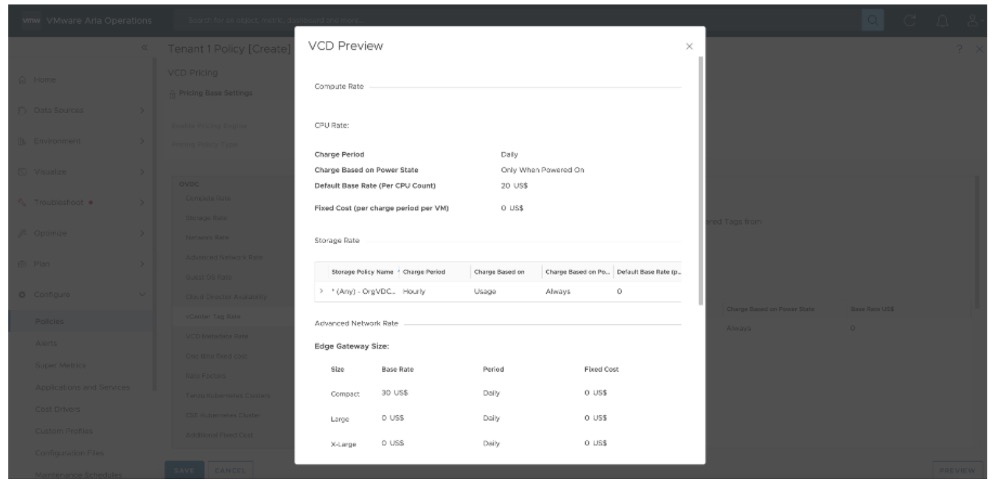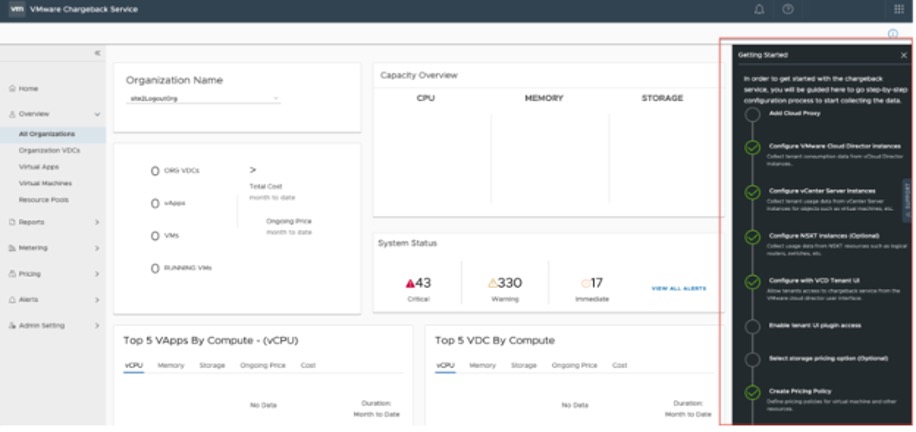VMware Cloud Foundation (VCF) is a private cloud with a full magazine that integrates the software defined calculation, storage and network along with cloud automation and management. The VMware Cloud Foundation Operations (VCF Operations), part of the VCF, offers the organization’s visibility to infrastructure, allowing them to optimize resource capacity, monitor performance and monitor their infrastructure health.
For VMware Cloud Services (VCSP) providers, it is essential to maintain financial transparency for its customers, while optimizing operating costs. VMware Futback, now part of the VCF (Trailly VMware Aria Operations) operations, allows you to allocate and restore the costs of cloud resources and services from users or departments that use them. VMware Cloud Director (VCD) helps VCSPS to manage more tenants in the same infrastructure. The fee needs this structure at the holder level to accurately allocate costs.
Understanding of backward collection VMware
VMware Funtback is designed to help VCSPS monitor resources and apply accurate cost models for tenant billing. It integrates smoothly with VCDs and other environmental environmental environmental environmentally, which ensures accurate financial responsibility. It can help manage and charge billing for the use of IT resources in various denials, business units and customers. As supported by robust tools and well -defined policies, it ensures that the cost of cloud services is managed in a direct, fair and easily understandable way.
Key features:
- Automated Cost Post: The fee assigns the costs based on the actual consumption of calculation, storage and use of network resources, allowing them to monitor their IT expenses and verify their fees by analyzing their use. Messages can be customized to display VM, application or service costs.
- Multi: VCSP can offer their tenants different billing models. This can complicate the tracking, allocation and billing process for each tenant. This is a place where Frifuback can help balance different prices with resource billing and allow the re -account models to the tenant as part of the VMware Cloud Director director. Administrators can enable the Pernant self -service panels, allowing them only to display their own virtual load, workload and infrastructure components.
- Flexible price models: Loadback supports solid, variable prices of gold graded price. In a model with fixed prices, the costs are defined and do not decorate on the basis of the use of resources, which offers the advantage of predictable budgets. The model with a variable price depends on the cost of using resources, causing effective use of resources. The range of graded prices offers more discounts for tenants, as the power consumption increases, allowing a scale.
- Own messages and dashboards: The fee allows users to use predefined templates or create your own messages to track specific metrics, and these messages can even be planned. Dashboards provide visual graphs in real time, graphs, thermal maps, etc., which can help identify the formulas in the data. The Prague -based warning can be provided by individuals. There is also a cluster level monitoring with aggregated use. Different types of dashboards available for tenants included dashboards based on memory, dashboard storage, control panels for network use, VM -based control panels, post -Summary dashboard and more.
- Integration with third -party systems: The fee works with external billing platforms such as SAP, Oracle, etc. through the API to automate the billing card or generating invoices. Organizations can extract data from the loadback and sweater into their preferred analytical platform or push the requirements into this system. On the other hand, management packages allow users to be specific, such as AWS, Azure, etc. They can allow capacitimity to charge in VC operations to track and track costs.
Integration Guide
- Optimization of Settings for Lessee Management: VCSP should develop that the Aria operations are allowed for their tenants. It serves as a foundation and provides visibility in cloud operations and attracts attractive to monitor, manage and optimize their activities. After activation, it unlocks a number of customized user experience.
- Gentle tuning of experiences: Administrators gain flexibility in adapting receivables and metrics available to tenants. This data acceptance is in line with the operating objectives of tenants and minimizes noise. Administrators can also control access to holding on the site and provide an experience adapted to precise operating requirements. The configurable retention period for billing and rental data ensures compliance with operating principles by deciding how long the data is stored and when it is discarded.
- Managing e -mail for commitment: E -mail configuration function allows you to set up notifications, alerts, and messages.
- Simplified Policy Management: The tool for the definition of policy simplifies the creation and management of price strategies, which makes billing invoicing effective and seizes. VCSPs can define, modify and fine -tune the price police to meet their operating goals and tenants’ expectations using an intuitive interface.
- Automated billing for financial accuracy: Invoicing process automation ensures Accraca, consistency and efficiency in each transaction. Accounts can be sent according to the defined schedule, which should be returned regularly to suit the dynamic needs of the tenants.
- Early notifications and reports: VCSPs can define the trigger criteria, assign a warning to the tenant’s profiles, set the rules for notifications, and select the conditions, frequency and channels (E -mail, SMS) to match preferential words. They can use reference to posts to simplify sharing VCD knowledge.
- Cost analysis for comparative prices: Users can compare metrics of cloud accounts vmware across objects, groups, applications and tenants. They can visualize data in graphs and tables for Insights Depeper and save an analysis for future use.
Why is VMware flostack necessary for VCSPS
For service providers, the VMware Cloud Director Infrastructure Infrastructure is a comprehensive set of tools that is equipped with basic features that like configuration capabilities, included trouble -free integration options, lessee access control and incoming E -mail and outgoing messages and announcements.

By integrating basic platforms such as VCENER, VCD, Cloud Director availability and NSX, service providers can use Redred well that the simplicity and accuracy of the reverse section. VCSPs can use the management packages for the above platforms and other options specific to their framework for cloud management.
1. Optimized cost renewal and profitability
The main challenge for VCSP is to ensure that all infrastructures and operating costs are effectively handed over to customers. VMware Fiostack eliminates the returned leak by providing a framework to allocate the cost for Accorated, to ensure profitability. It prevents mistakes associated with manual monitoring and separates costs by separation or customer. Cloud providers can use VMware Fliotback to further monetize their officers by charging higher rates for premium sources, such as low lute networks or reserved CPSE sources (prices based on allocation).
2. Transparency and trust with customers
Customers expect them to apply for their use and billing. VMware Flockback provides detailed links to show exactly how much for each resource, helps VCSP to justify fees and build customer confidence by hidden no costs to reduce billing disputes. Tenants will get access to real -time billing data to prevent surprises. Since customers are loaded when using messages, it eventually reduces unnecessary resources, optimizes workload and helps customers avoid fees for unused resources.

3. Operating efficiency and automation
Manual cost monitoring is time consuming and susceptible to errors. VMware Flockback automates using measurements, administrative reduction of overhead costs, and allow service providers to focus on value added services. This makes it easier for them to master billing for a large number of customers. Providers can also plan capacity exactly according to the view of historical data from messages.
4. Monitoring over VM::
Users can monitor the performance of the application level and look at API responses, web server load, and dependence on viewing application how workload interacts with VCF operations. They can also monitor Kubernetes and containers to monitor nodes, services and health of clusters. Network monitoring and security helps with micro segmentation segmentation analysis and look at network traffic, latency, etc. This observation is necessary for VCSPs necessary for planning and charging.

5. Support of a private cloud
For VCSP offering private cloud solutions, VMware Flockback expands the private cloud uniified Flificback in the area, while providing Finnish responsibility and transparency in internal billing.
Conclusion
The visibility of the cloud costs is essential for each organization and the integration of the system of the back system into the VCSP business model is a change in the game for scalabibility and growth. It allows customers to adapt flexibility to use resources based on demand and pay only for what they use. Users can monitor performance, costs and capacity and help them optimize their infrastructure investments. The fee allows VCSP to solve the needs of another client by offering different price models. Tenants gain access to self -service dashboard, reports and alerts that improve their overall experience. A well -implemented charging system creates a competitive advantage for VCSP. More information can be found here.
(Tagstotranslate) fee

